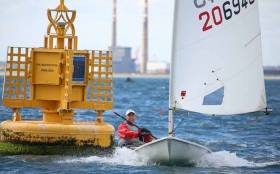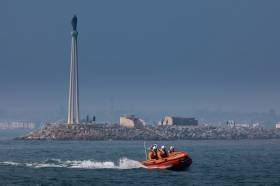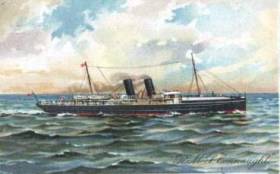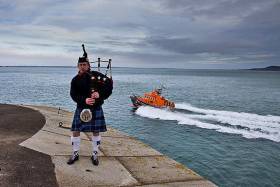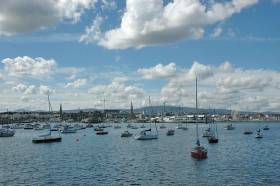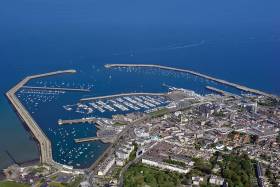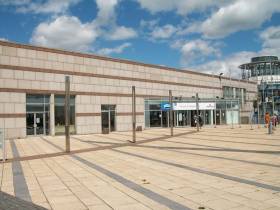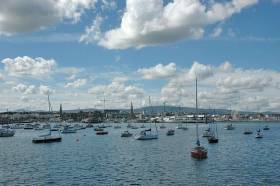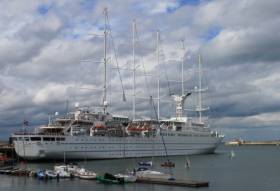Displaying items by tag: Dun Laoghaire
DBSC Laser Class Shout Out for 'Nippers & Oul Fellas'
Is your Laser dinghy sitting in your garden? Maybe your teenager doesn't want to use it anymore? If you can answer 'yes' to either question, then Dublin Bay Sailing Club (DBSC) Laser class has the answer for you, if you're looking for some good quality, short, sharp dinghy racing this Summer.
With an existing fleet of 20 plus boats that includes hotshots and novices, full rigs and radials, 'nippers and oul fellas', the first gun is Tuesday, April 25th near Dun Laoghaire Harbour.
Laser Class Captain Ross O'Leary also points out that not being a member of a Dun Laoghaire Yacht Club is 'NO PROBLEM' because a store & launch facility is available via Dun Laoghaire's Coal Harbour for €200 per season.
Racing usually takes place in Scotsman’s Bay or in harbour in extreme conditions.
Download the class flyer below for details.
#RNLI - Dun Laoghaire RNLI’s inshore lifeboat was called out twice yesterday (Thursday 16 March) to separate instances of kitesurfers in distress.
The first callout was to Dollymount Strand on Bull Island across Dublin Bay, in which the casualty was landed ashore to Howth coastguard volunteers.
The second was off Sandymount, with the kitesurfer involved landed to the care of Dun Laoghaire’s Irish Coast Guard unit.
No medical attention was required in either incident.
Lecture: "Leinster's Sister: The Sinking of the RMS Connaught"
#RMSconnaught - In 2018 is the centenary of the sinking of mail-boat RMS Leinster off the Kish Light by a German U-Boat in WWI, what is less well known is the sinking of sister RMS Connaught on 3 March 1917.
To mark the historic occasion the National Maritime Museum of Ireland, Dun Laoghaire is to host a lecture about the event by distinguised author and historian Phillip Lecane.
Wreath For Caitríona Lucas As Dun Laoghaire RNLI Remembers Lives Lost At Sea In Christmas Eve Ceremony
#RNLI - A special wreath will be laid to commemorate the loss of Irish Coast Guard volunteer Caitríona Lucas during Dun Laoghaire RNLI’s annual Christmas Eve ceremony to remember all those who lost their lives at sea in the past year.
The annual commemoration marks the anniversary of the 15 volunteer lifeboat crew members from Dun Laoghaire RNLI who died during a rescue on Christmas Eve in 1895.
The short ceremony is held at the lighthouse at the end of the East Pier in Dun Laoghaire at midday on Christmas Eve. The service includes music, an ecumenical blessing, a reading of a newspaper account printed at the time of the 1895 tragedy, and concludes with a guard of honour for the wreath-bearers as they proceed to sea on the lifeboats to lay the tributes.
The ceremony will last about 20 minutes with upwards of 200 people, including families, expected to walk the pier to join the ceremony at noon.
In previous years, two wreaths have been laid at sea but this year a third will be added in memory of Caitríona Lucas of the Irish Coast Guard unit at Doolin, who died during a search operation on 12 September this year.
A guard of honour will be provided by the Dun Laoghaire Coast Guard Unit and Civil Defence volunteers, while the Dun Laoghaire RNLI lifeboats will carry the wreaths to sea a short distance from the pier.
“This is an especially poignant time of year for many people who have lost loved ones at sea but 2016 will be particularly remembered by all of us involved in rescue services around Ireland,” said Stephen Wynne, lifeboat operations manager with Dun Laoghaire RNLI.
“Caitríona symbolises the commitment we all share for helping others in need; she will not be forgotten.”
Local musician William Byrne will perform a ballad marking the 1895 tragedy, while journalist Fergal Keane will read a newspaper account from that era followed by an ecumenical blessing.
Dublin Fire Brigade piper Paul McNally will play a lament at the East Pier saluting station at the end of the ceremony that has been kindly facilitated by the Dun Laoghaire Harbour Company.
One of the attendees will be Cormac Becton, great grandson of Edward Murphy, a volunteer lifeboat man who lost his life during the rescue of the Palme in 1895.
“For many years as a young child Christmas Eve meant the nativity until I heard the story of my great Grandfather,” said Becton. “Now when I hear winter gales I think of him and the brave lifeboat crew as they rowed out of the harbour.
“The site of the ceremony on Christmas Eve is so close to where they died it isn't hard to imagine the scene and the challenge they faced.’
Due to forecasts of strong winds at the weekend, contingency plans are in place to ensure the ceremony proceeds safely. This may mean the ceremony will be moved closer to the lifeboat station. Attendees will be advised with stewards in place.
#CruiseBerth - Afloat.ie has learned that the Dun Laoghaire Combined Clubs (DLCC) will not seek a judicial review of An Bord Pleanála’s approval of a scaled-down cruise berth for Dun Laoghaire Harbour.
DLCC members, who welcomed the 250m limit on the proposed cruise liner berth, recently met to discuss the planning decision and whether a review was warranted based on interpreted material changes to the permission sought, based on objections or suggestions from DLCC and others.
However, it was agreed not to launch a joint appeal for reasons of cost, and that the reduced maximum scale of the cruise berth changes its commerciality such that may never proceed.
However, the joint decision does not prevent any of DLCC’s constituent yacht clubs or individuals from seeking judicial review before the deadline of Wednesday 28 December, three weeks from today.
Meanwhile, DLCC members are seeking contributions to cover a shortfall associated with the extended oral hearing over the cruise berth proposals.
Dun Laoghaire Yacht Clubs Must Put On a United Front
Combining efforts and pooling resources are key to securing the future of yacht racing from Dun Laoghaire’s legacy waterfront clubs, writes David O’Brien
Welcome to Dun Laoghaire, the cradle of world yacht racing. It's here that the modern rules for the sport were written in the 1870s. And today, the location still boasts the top sailing waters of any capital city, plus the finest Georgian yacht clubs anywhere in the sailing world, with not one but three world class clubhouses in a row on the waterfront — namely the Royal St George, now in its 178th year; the National Yacht Club, which celebrates its 150th anniversary in 2020; and the Royal Irish, the eldest of the three at 185. Celebrating over fifty years on the West Pier is the more recent Dun Laoghaire Motor Yacht Club.
Though they developed individually, this year and last these clubs have had a joined purpose, focused on saving sailing from the perceived threat of a giant cruise liner berth in Dun Laoghaire Harbour.
But ironically, the real threat to the sport lies elsewhere. A decline in sailing numbers and a change in sporting trends are putting a strain on these ancient yacht clubs, leaving them shorn of membership, marooned in their own harbour.
These clubs have at their heart a dedicated and hard-working membership who are passionate about sailing. It is far removed from the recent view in the Sunday Independent, quoting an unnamed source to describe their different ethoses in unflattering terms: “The one nearest the city, the Royal Irish Yacht Club, is for protestants, the one furthest, the National Yacht Club, is for Catholics, and the one in the middle, the Royal St George, is for Catholics who think they're protestants.”
Anyone involved in sailing will tell you that’s rubbish from a bygone era. Unfortunately, it hints at what those outside the sport might still think of it.
Added to this, recession and austerity have been tougher on equipment sports such as sailing, where the running costs are relatively high. It's not only an Irish problem, but it has caused great cracks in Dun Laoghaire's historic sailing lines.
Their stuffy Victorian image, too, hasn't helped to recruit new members, as participation continues to drop. The number of sailors that remain in Dun Laoghaire may total up to 5,000 but not all are yacht club members, and many are getting on in years.
Insiders says there’s a window here for about five years while the domestic sailing classes still have a good turnout. After that, it’s feared the whole scene could disappear — not helped by a lack of cash among thirty–to–fifty–somethings.
It’s a problem throughout Northern Europe. The Dutch, for example, foresee a 25% reduction in their national fleet by 2050.
Unique propositions
Dun Laoghaire clubs have traditionally enjoyed two unique selling propositions for well over 100 years, but both have disappeared over the last two decades.
Firstly, the clubs once enjoyed an unmatched reputation for first-class, exclusive dining, but this has been eroded to such an extent by the emergence of quality high-street restaurants that some clubhouses no longer offer a daily service. The clubs have lost their social cachet.
Secondly, the clubs once controlled access to the water through harbour moorings and the slipway. However, since the opening of the country’s largest public marina in 2001, boat owners no longer need to be yacht club members to go boating.
It's not all doom and gloom; there are parts of sailing in rude health, especially in Olympic-style youth competition. Yet crucially, this has not transferred to senior fleets who are more inclined to take out yacht club memberships at approximately €1,500 per annum.
If we don't respect our past then we'll find it harder to build our future. Dun Laoghaire's institutions have survived many crises including two world wars and countless recessions. It's proof of the enduring love of sailing in the capital's waters.
An Irish Sailing Association (ISA) task force has been charged with finding a way to link its high performance sailing initiatives to domestic classes. In 2006, the ISA had 22,000 members; 10 years on and numbers are back down to 1996 figures at around 17,500.
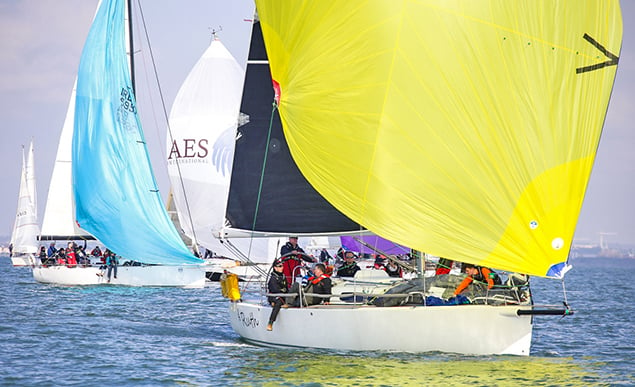 Fun Racing in DBSC's Winter Turkey Shoot series and offshore racing with ISORA has flourished in recent years
Fun Racing in DBSC's Winter Turkey Shoot series and offshore racing with ISORA has flourished in recent years
A new model for the sport – SAILING is the real USP
Ironically, the club that first coined the yacht racing rules, the clubhouse-less Royal Alfred Yacht Club (RAYC), was wound up last year and incorporated into the much larger Dublin Bay Sailing Club (DBSC). The move is symbolic because it presages a much bigger need to rationalise other aspects of the sport in the harbour.
Dun Laoghaire – or Kingstown as it was in the Victorian era – is where the racing rules were first drawn up and the modern sport of yacht racing was born. If a new regeneration plan can be hashed out, it may well become the place where a new model for the sport is born, too.
Critical to the solution is to bring SAILING to the forefront, make the sport more accessible and reduce the cost of taking part.
In the good times, everyone helped themselves to a slice of the yachtsman pie to the extent that between various membership and berthing fees, it still costs upwards of €10,000 per annum to campaign one of the harbour's standard keelboats, equivalent in some cases to the purchase price of the boat.
Sailors themselves have already worked out ways to circumvent the rules to keep their own costs down. Anecdotally, we know some have ditched the boat altogether and are crewing on other boats. Others are competing only at events and not participating in club sailing, the heart of the sport. Often sailors are going directly from the marina without joining a club at all. In some cases, one sailor from a crew of 10 is nominated to join a club, just to comply with racing rules.
In order to maintain these trappings of yesteryear, while unable to generate it from a dwindling sailing membership, the club administrations have gone after other revenue streams. Currently weddings and corporate events are the order of the day.
In many ways, this redirection compounds the problem for the sport, because in order to compete for such business against more established operators in the hospitality sector, the clubs have to gear up on staff and senior management to run these events successfully. Currently the waterfront wage roll is approaching €3 million per annum. The question is, how much of this money is going to run sailing, and how much to run weddings? Is it the case that neither are being served well?
This is not the fault of current committees, who are merely custodians of these protected structures and are charged with the not insignificant upkeep of these historic buildings but if you do what you always do you will get what you always get.
So how can we keep what we have and bring 'Sailing' to the forefront?
Surely rather than to look inward we should look for a solution that can grow the sport to benefit everyone and chart a future for not just the clubs but all the stakeholders in Dun Laoghaire and the Sport. This is not to throw out what we have but to develop that new extra dimension to Dun Laoghaire sailing that is missing. It is to recognise that life is different for the younger generations and unless we change tack we are making it very difficult for interested sailors to enjoy the sport through club membership.
Other marine sports like SUP, kayaking, kite surfing are growing immensely in popularity. They don’t require a club, a boat and a bar tab or a marina berth so there is competition coming from all sides.
Surely there could be a collective solution to fix the problem of making sailing less expensive? Hard choices need to be made, not only to save the clubs per se but the sport itself.
A collaboration of the stakeholders would rationalise costs and could bring–in a much larger public element that would sustain the sailing scene. With Dublin city on the doorstep surely there is a market to provide the capital's population with simple sailing and shore facilities? If the clubs could tweak the existing offering, the scene could be much more embracing.
And there are examples where 'tweaks' have already borne fruit. New initiatives for offshore sailing under ISORA and winter racing via DBSC's impressive Turkey Shoot are positive signs that sailors respond well to new ideas when they combine leadership, fun racing and shoreside craic. And every two years the clubs combine to produce Ireland's largest regatta at Dun Laoghaire a fleet that has, at times, topped 500 boats.
 Every two years since 2005 Dun Laoghaire's waterfront clubs combine to produce Ireland's biggest sailing regatta that attracts as many as 500 boats
Every two years since 2005 Dun Laoghaire's waterfront clubs combine to produce Ireland's biggest sailing regatta that attracts as many as 500 boats
Addressing the core issues
If Dun Laoghaire’s clubs can get the sailing right, everything else can flow from there. This is a big question but a good start would be to focus the combined efforts of the stakeholders to address how they adapt to the changed environment. Because if they don’t, everyone will suffer in the long term. A start would be to recognise that:
- Combined membership of the waterfront clubs has been static over past two years and is still 30% below 2006 levels.
- Racing fleets are declining and high costs are fuelling a move to access the water from outside the club networks.
- The clubs are all running active junior programmes, but have poor conversion to membership.
- The clubs are struggling to keep the young adult group (ages 25–40) actively involved.
- The clubs are failing to attract significant newcomers or ‘try sailors’ into club membership.
- Clubs need to direct more resources to support existing sailing members and to attracting new sailors.
Right ingredients
As a centre of sailing, not just for Ireland but for Europe, and even the world, Dun Laoghaire has all the right ingredients to be successful.
A population of over one million is right at its doorstep, while the town itself boasts a large and firmly established club network and race organisation, a sizeable public sailing school with excellent facilities and easy access to the sailing area, plus a supportive county council and harbour authority.
So why are Dun Laoghaire’s clubs still struggling? One problem is that they are too focused on senior membership and trying to use the ‘old model’ to address this new environment.
Time (or the lack of it) and costs (higher than they ought to be) are key deterrents for the young adult group. Participation requires a disproportionate financial commitment, and organised racing as it stands often doesn’t fit with family and work commitments.
Maintaining club facilities, meanwhile, requires an ever larger proportion of available financial resources, leaving less for sailing.
What’s more, a duplication of resources in sailing across the waterfront is forcing up costs for all sailors. The end result is that existing structures are not conducive to attracting newcomers to the sport.
An alternative approach
The setup in Dun Laoghaire would likely be very different if one were starting afresh today. There would be far less duplication and a more joined-up approach between the key stakeholders.
Rather than working to their combined strengths, each are driving their own individual agendas, overlaying more levels of costs that have brought sailing to a prohibitive level and isolated the sport from younger sailors and newcomers alike.
While it is not realistic to look at a new direction in terms of a clean sheet, it is possible to consider developing a more combined approach, and look at areas that can be changed and which will have an impact thus allowing development using the existing structures across the waterfront.
Rather than be thinking of a one-club/joint-club approach and compromising the individual club identities, or working in isolation, why not think about playing to the combined strength that exists and has been proven to work. There are many opportunities to share resources from boatyard services to back office administration to combine activities to help address the current situation but a good area to start would be sailing itself.
The stakeholders here are not just the waterfront clubs – all the stakeholders have a part to play:
- The waterfront clubs: National Yacht Club (NYC), Royal Irish Yacht Club (RIYC), Royal St George Yacht Club (RSGYC) and Dun Laoghaire Motor Yacht Club (DMYC).
- The Irish National Sailing and Powerboat School (INSS) and other schools
- Dublin Bay Sailing Club (DBSC), the racing organisation for the waterfront clubs
- Dun Laoghaire-Rathdown County Council (DLRCoCo) and Dun Laoghaire Harbour Company (DLHC).
- Dun Laoghaire Marina.
- Other Dun Laoghaire based groups such as Sailing in Dublin (SID)
The challenge will be for all these stakeholders to put individual agendas aside and to work openly together seeking ways to:
- Bring the cost of sailing down
- Create an additional racing ‘offering’ that is less time-consuming, less expensive and more attractive for young adults
- Reduce duplication of resources to create a stronger, more cost-effective junior sailing model that is open to newcomers
- Focus the clubs on sailing as much as club facilities
Bringing the cost of sailing down
Current costs of racing in Dun Laoghaire are too high, and there is no real benefit to being a member of one of the waterfront clubs. The clubs need to look at reducing the cost of racing and perhaps finding ways of including DBSC boat membership into the club subscription, for example.
Waterfront club members could also be offered a discounted entry to regattas if paid as part of an annual subscription. Meanwhile, DBSC could charge a premium for those wishing to race who are not members of the waterfront clubs or the INSS.
The clubs need to look at altering the membership structures to reward boat ownership by discounting members with boats parked on their forecourts, or negotiate a discount — or even lease a section of berths — from Dun Laoghaire Marina for their members’ yachts.
New membership structures can be introduced to cater for those transitory 25–40–year–old sailors struggling with time and money pressures to keep them linked with the club and giving them the opportunity to charter club boats for racing.
Creating a more complete ‘race offering’
Racing in Dublin Bay is organised to a high or ‘championship’ standard and works very well for the keen keelboat boat owners. But these are not a growing fleet and this comes at a cost – it is expensive to run, can intimidate the beginners/fun sailors and doesn’t embrace all the potential constituents. There is a need for both ‘fun club racing’ and the more serious ‘championship style’. Maybe the focus could be shifted to embrace both elements to grow the appeal and the clubs integrate social activities and prizegivings for sailors on the less demanding fun club racing days.
Club racing that appeals to the full spectrum of club members should be provided – from junior, through college, and to seasoned campaigners in both dinghies and keelboats.
The waterfront clubs could introduce a new additional format of racing directed at young adults and those using club-owned boats, at a time and frequency that suits, such as multiple short races in the harbour area on evenings and Saturday mornings.
Inter-club and business leagues are also a potential direction, as is a low-cost team racing league directed at students.
In addition, junior racing could be included with dinghy racing in the annual race programme and then everyone looking to race in Dun Laoghaire would be catered for, boat ownership encouraged and memberships increased.
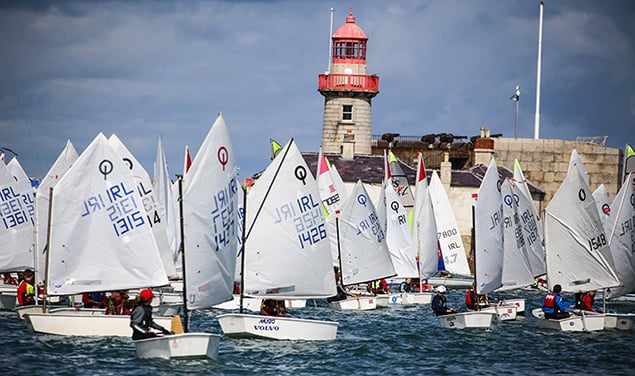 The popular combined DBSC Junior September series. If other junior activities were combined it would provide critical mass for a common ‘class policy’ and to enable streaming of sailors into like-minded groups
The popular combined DBSC Junior September series. If other junior activities were combined it would provide critical mass for a common ‘class policy’ and to enable streaming of sailors into like-minded groups
Create a stronger, more cost effective, open junior sailing model:
The importance of getting sailors involved at an early age is known to all, and is borne out by a recent British Marine Federation survey that found some 40% of sailors started as a child, while 30% were introduced to the sport by family or friends.
Dun Laoghaire has a unique opportunity to pool resources for a dynamic junior and youth sailing training environment. That is, if the clubs can come together with, for example, the INSS and DLRCoCo to form a combined organisation to run the club junior sections, and develop a public or newcomers element – the focus here being on combining the on-the-water elements:
- Run one programme in which everyone participates (no change in location of boats, etc).
- Use common instructors.
- Combine the sailors afloat at the various levels.
- Pool RIBs and equipment.
- Hire professional administration to ensure continuity and maintenance of standards.
The potential benefits of this approach are many. Elimination of duplicated costs, the increased scale would enable the employment of a high-calibre instructor to focus on the fun aspects of getting involved in sailing, as well as a specialist coach to focus on the most talented sailors and stream the best prospects for competition.
Combining the junior sections would provide critical mass for a common ‘class policy’ and to enable streaming of sailors into like-minded groups, which will be more enjoyable for the sailors, and bolster clubs’ membership retention efforts.
A single organisation would be more cost-effective than the existing stand-alone operations, and would also create a structure to enable newcomers to become more integrated into Dun Laoghaire’s sailing community, again resulting in stronger club membership.
The goal is a ‘Dun Laoghaire culture’ among future members, rather than unnecessary club rivalries. At the same time, there should be no loss of individual club identity; there hasn’t been a problem combining for DBSC racing, after all.
A united waterfront would put Dun Laoghaire in a strong position nationally to attract top young sailors and national training squads.
Such a move would also demonstrate the right ‘joined-up thinking’ to DLRCoCo, and provide a platform to develop schools and community programmes in conjunction with them.
In late August, the harbour's first Olympic medal brought the yacht clubs, the town marina, the local sailing school, the boatyard, the town council and the harbour company together in celebration like never before. Maybe all we need is Annalise Murphy–style determination? Is it possible that her Olympic Silver could be the inspiration to put Dun Laoghaire on a new tack?
Modern communications, and in particular social media's 'electronic word–of–mouth', means no other generation has had the same chance to shape the future like we do. It's up to us how we do it but surely it is better to bake a bigger pie than fight over the remaining crumbs?
A definitive plan for 'Dun Laoghaire Sailing Inc' must be the first step. As all sailors will tell you, it is the set of the sails not the direction of the wind that determines which way you will go.
Let's Make Dun Laoghaire Sailing Great: We are keen to hear from readers on this very pertinent subject. All ideas and proposals welcome. Please let us have your comments below.
Former Stena HSS Terminal To Let In Dun Laoghaire
#DLHarbour - The Irish Times is reporting that the former ferry terminal at St Michael’s Pier in Dun Laoghaire is available to rent.
A 10-year lease at €215 per square metre is being quoted by letting agent Lisney for the front section of the terminal building, built in the 1990s for the Stena HSS to Holyhead which ended service last year.
More recently the building hosted the Endurance Exhibition on Shackleton’s Arctic exploits, which has since moved to the United States.
The news comes just days after An Bórd Pleanála gave the go-ahead for a cruise terminal in the harbour that will accommodate 80% of ocean liners that currently visit the capital.
It also follows last week’s announcement of a partnership between Dun Laoghaire Harbour Company and online platform Fillit to facilitate the temporary rental of St Michael’s Pier and three other spaces on the waterfront for various events.
#CruiseBerth - Dun Laoghaire Harbour Company has welcomed the granting of planning permission for a new cruise liner berth.
As reported earlier today on Afloat.ie, An Bord Pleanála has given the go-ahead for a scaled-down development, accommodating cruise vessels at a maximum 250m in length.
In a statement this afternoon, the harbour company estimates that even this reduced sized berth “could attract 50 cruise calls a year” with an average of 2,000 passengers and crew per call, contributing €10 million to the local economy each season.
“Today's positive outcome now enables cruise tourism in Dublin to significantly grow by allowing Dublin's two ports – Dún Laoghaire and Dublin – to collaborate and work with other stakeholders to exploit this great tourism opportunity,” said DLHC chair Eithne Scott Lennon at the news.
Afloat.ie understands that the Dun Laoghaire Combined Clubs will hold a meeting with the club commodores this evening (Friday 4 November) to discuss the planning decision and its implications.
Cruise Berth Granted in Dun Laoghaire
#CruiseBerth - An Bord Pleanála’s long-awaited decision on the proposed new cruise berth for Dun Laoghaire is in — and gives the green light for the cruise liner berth.
In a statement on the ruling as seen by Afloat.ie, the planning board has granted permission for a berth to accommodate ships of a maximum 250 metres in length, short of the 340m originally sought to future-proof the harbour for ever larger cruise ships.
The board says its decision to curtail the scale of the Dun Laoghaire Harbour Company development was in compliance with relevant Natural and environmental impact statements, as well as in accordance with the National Ports Policy.
The statement also says the 250m limit “would enable the development of an appropriate level of commercial cruise tourism within the harbour” and “strike an acceptable balance between commercial development … and protecting the amenities of recreational users.”
More on this story as it develops.
Dun Laoghaire Harbour Company Partners With Online Platform For Leasing Event Space
#DLHarbour - Dun Laoghaire Harbour Company has announced a new event space partnership with online platform Fillit.
Four locations in the harbour will be available for rent on short-term lease for various events, pop-ups and other promotions via the new web startup “that connects people and spaces”.
The Dun Laoghaire-based company aims to provide a one-stop shop for event planners of all scales to connect with ‘landlords’ who have available space on a temporary.
The harbour plaza, the East Pier bandstand and sun shelter, Carlisle Pier and St Michael’s Pier will all be made available through Fillit for hosting events similar to those held in the harbour in the past, such as the Red Bull Flugtag and the Beatyard festival.
The news comes just weeks after the harbour company announced its plans for an urban beach are ‘on hold’ pending ‘organisational restructure’, as previously reported on Afloat.ie.


























